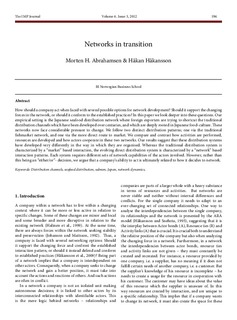Networks in transition
Journal article, Peer reviewed
Permanent lenke
http://hdl.handle.net/11250/93702Utgivelsesdato
2012Metadata
Vis full innførselSamlinger
- Scientific articles [2181]
Sammendrag
How should a company act when faced with several possible options for network evelopment? Should it support the changing forces in the network, or should it conform to the established practices? In this paper we look deeper into these questions. Our empirical setting is the Japanese seafood distribution network where foreign exporters are trying to shortcut the traditional distribution channels which have been developed over centuries, and which are deeply rooted in Japanese food-culture. These networks now face considerable pressure to change. We follow two distinct distribution patterns; one via the traditional fishmarket network, and one via the more direct route to market. We compare and contrast how activities are performed, resources are developed and how actors cooperate in these two networks. Our results suggest that these distribution systems have developed very differently in the way in which they are organised. Whereas the traditional distribution system is characterized by a “market” based interaction, the evolving direct distribution system is characterized by a “network” based interaction patterns. Each system requires different sets of network capabilities of the actors involved. However, rather than this being an “either/or”- decision, we argue that a company’s ability to act is ultimately related to how it decides to network.
Beskrivelse
This is an open access journal: http://www.impjournal.org/
